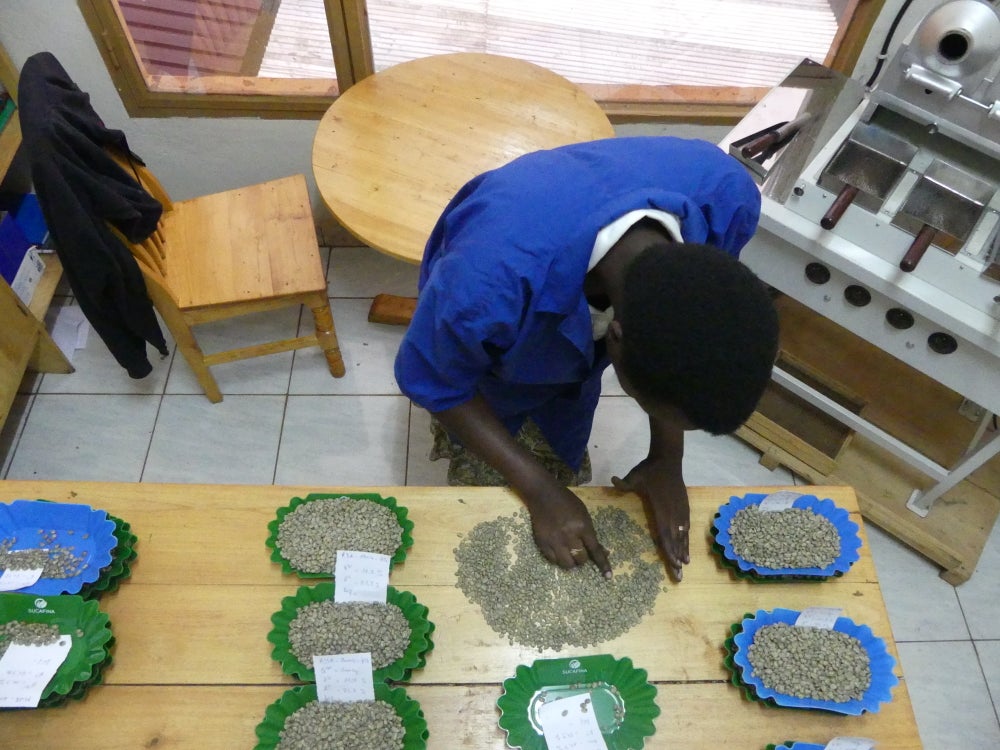From the Lab
Monday, September 9, 2019
How Common is Potato Defect, Really?
If you’ve tasted or purchased a Rwandan, Burundian or Congolese coffee, you’ve probably heard of potato defect. Potato defect is when roasted, ground and brewed coffee smells and tastes like raw potato. It might seem frightening and omnipresent, but the truth is that potato defect is much less ubiquitous than we in the coffee industry have come to anticipate. We turn to research done by Chelsea Thoumsin at Counter Culture Coffee, a coffee professional who’s done extensive research on potato defect.

What is Potato Taste Defect?
Before we tackle the numbers, let’s learn a bit more about potato taste defect. Though for many years the cause of potato defect was contested, scientists and industry professionals have since come to a consensus on its origins. Potato defect occurs when airborne bacteria enters a puncture or tear in the outer skin of the coffee cherry. Such tears can happen for a number of reasons. The most common reason is the Antestia (Antestiopsis orbitalis), a small, sucking insect that creates holes in the outer cherry that enable the bacteria to enter. Other causes include rapid ripening due to extended rains that lead the skin to rupture or boring insects that can drill tiny holes into the coffee cherry, such as the coffee borer beetle (Hypotenemus hampei).
Chemically, potato defect is caused by a pyrazine, a symmetrical aromatic compound, called isopropyl-2-methoxy-3. Pyrazines are common features in the food and drinks we so love. Fresh bell peppers, peas and beetroots all contain pyrazines. White wines made from Sauvignon Blanc grapes also contain pyrazines. In fact, it is the pyrazines in the grapes that make the peppery and herbaceous flavors of white wine that we so enjoy. Not all pyrazines are as delicious as those in Sauvignon Blanc, however. Pyrazines are a class of compounds and the pyrazine that causes potato defect is different from those that cause peppery flavors in white wine.
What’s to Blame?
It’s important to remember that potato defect is not verifiably linked to processing error or lack of farmer oversight. Unlike phenol or overripe beans, potato defect is not a preventable defect. While some have found success using intensive sorting techniques to reduce incidences of potato defect, for the most part, the defect cannot be completely avoided, even by introducing better harvesting, sorting or processing techniques. “As of now there’s no way to get rid of 100% potato defect in coffees from Rwanda, Burundi, DRC and parts of the Congo,” said Thoumsin.
Crunching the Numbers
By grinding more than 5,000 grams of each of the coffees they offer on their menu, Thoumsin found that the average rate of defect is 1 bean per 1,150 grams of coffee. That means there’s one potato defect in every 1.15 kilograms. Though the instance rate is slightly higher with natural coffees, it’s still not much to sneeze at. This is corroborated by our own data.
The occurrence of potato defect in coffee does mean it’s worthwhile to pay “attention when baristas and roasters grind these coffees” said Thoumsin. Thoumsin and Counter Culture Coffee recommend that staff and customers grind small batches of these coffees at a time. For instance, if grinding 250g for batch brew, one would grind 50g at a time, checking for potato defect in each batch before combining them for brewing.
Say you do find potato in a batch of ground coffee, “the protocol for dealing with that is also very important,” said Thoumsin. “They should flush the grinder thoroughly (20-30 grams or so, ideally with a Latin American coffee or other origin with zero [potato defect]) to prevent cross-contamination. Many times, baristas/roasters think they are experiencing successive potato instances when really, it’s the same one from the prior batch.”
The Bottom Line
The bottom line, according to Thoumsin, is that Rwandan, Burundian and Congolese coffees can be excellent, making the risk of potato defect worth it for the chance of an exceptional coffee experience. “I can speculate a lot about different methods to eliminate [potato defect] altogether,” Thoumsin said. However, Thoumsin said, considering it is a defect that occurs about 1% of the time or less, she feels that the necessary change lies more in our perceptions of these coffees that in making changes at origin. As importers and roasters, we should recalibrate our understanding of these coffees and in recognizing their potential for greatness and the low average instance of potato defect, embrace them.
Sucafina North America’s Susan Wilcox, Coffee Quality Controller, Q Grader, talks about her extensive experience with East African coffees and her appreciation for their rich and varied flavors and the role of Sucafina’s partner companies—RWACOF (Sucafina in Rwanda) and Greenco in Burundi—who use rigorous sorting techniques to lower instances of potato defect. “East Africa gave the world coffee, and to this day, still produces some of the most complex and beautiful coffees that I’ve ever cupped. In my role, I have had the opportunity to cup hundreds of East African samples. Though I admit I am biased because our origin operations in Burundi and Rwanda implement thorough processing and sorting methods that help mitigate the presence of the potato defect, I’ve fallen in love with the delicate florals and juicy berry notes that we often see in coffees coming out of Burundi and Rwanda.”
By educating ourselves on ways to avoid contaminating too many grounds with defective beans and making space for these coffees in our palates and programs, we can improve our coffee programs and increase awareness of great coffees from these origins.